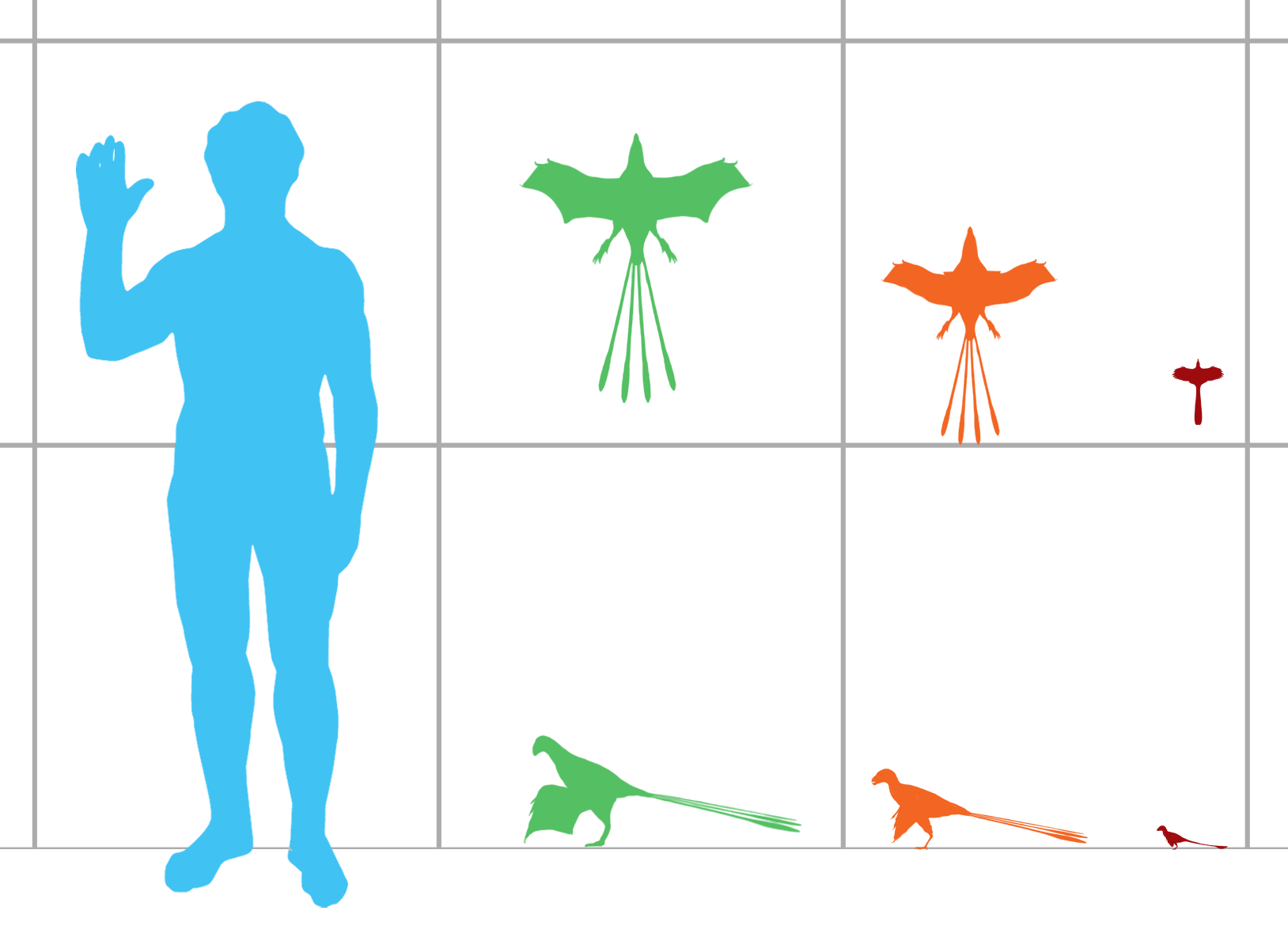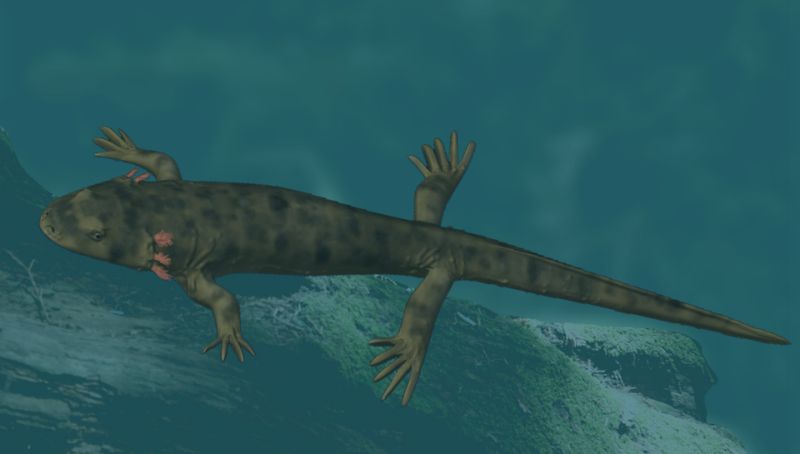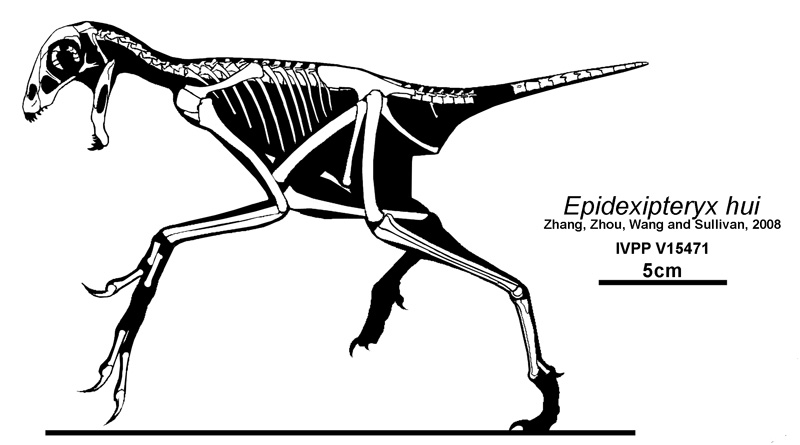|
Scansoriopterygids
Scansoriopterygidae (meaning "climbing wings") is an extinct family (biology), family of climbing and gliding maniraptoran dinosaurs. Scansoriopterygids are known from five well-preserved fossils, representing four species, unearthed in the Tiaojishan Formation fossil beds (dating to the mid-late Jurassic Period) of Liaoning and Hebei, China. ''Scansoriopteryx , Scansoriopteryx heilmanni'' (and its likely synonym ''Epidendrosaurus ninchengensis'') was the first non-avian dinosaur found that had clear adaptations to an arboreal or semi-arboreal lifestyle–it is likely that they spent much of their time in trees. Both specimens showed features indicating they were juveniles, which made it difficult to determine their exact relationship to other non-avian dinosaurs and birds. It was not until the description of ''Epidexipteryx hui'' in 2008 that an adult specimen was known. In 2015, the discovery of another, larger adult specimen belonging to the species ''Yi (dinosaur), Yi qi' ... [...More Info...] [...Related Items...] OR: [Wikipedia] [Google] [Baidu] |
Yi (dinosaur)
''Yi'' is a genus of scansoriopterygid dinosaurs from the Late Jurassic of China. Its only species, ''Yi qi'' (Mandarin pronunciation: ; from and ), is known from a single fossil specimen of an adult individual found in Middle or Late Jurassic Tiaojishan Formation of Hebei, China, approximately 159 million years ago. It was a small, possibly tree-dwelling (arboreal) animal. Like other scansoriopterygids, ''Yi'' possessed an unusual, elongated third finger, that appears to have helped to support a membranous gliding plane made of skin. The planes of ''Yi qi'' were also supported by a long, bony strut attached to the wrist. This modified wrist bone and membrane-based plane is unique among all known dinosaurs, and might have resulted in wings similar in appearance to those of bats. Discovery and naming The first and only known fossil specimen of ''Yi qi'' was found by a farmer, Wang Jianrong, in a quarry near Mutoudeng Village ( Qinglong County, Hebei). Wang sold the fossil to the ... [...More Info...] [...Related Items...] OR: [Wikipedia] [Google] [Baidu] |
Ambopteryx
''Ambopteryx'' (meaning "both wing") is a genus of scansoriopterygid dinosaur from the Oxfordian stage of the Late Jurassic of China. It is the second dinosaur to be found with both feathers and bat-like membranous wings. ''Yi'', the first such dinosaur, was described in 2015 and is the sister taxon to ''Ambopteryx''. The holotype specimen is thought to be a sub-adult or adult. The specimen is estimated to have had a body length of and a weight of . The genus includes one species, ''Ambopteryx longibrachium''. Etymology The generic name ''Ambopteryx'' is derived from the Latin word ''ambo'' meaning "both" and Ancient Greek word ''πτέρυξ'' (''pteryx'') meaning "wing", a reference to the animal's membranous wings and bird-like body plan. The specific name ''longibrachium'' is derived from the Latin words ''longus'' meaning "long" and ''brachium'' meaning "upper arm". Holotype The holotype specimen, IVPP V24192, is an articulated and nearly complete skeleton with associ ... [...More Info...] [...Related Items...] OR: [Wikipedia] [Google] [Baidu] |
Tiaojishan Formation
The Tiaojishan Formation is a geological formation in Hebei and Liaoning, People's Republic of China, dating to the middle-late Jurassic period (Bathonian- Oxfordian stages). It is known for its exceptionally preserved fossils, including those of plants, insects and vertebrates. It is made up mainly of pyroclastic rock interspersed with basic volcanic and sedimentary rocks. Previously, the Tiaojishan Formation was grouped together with the underlying Haifanggou Formation (also known as the Jiulongshan Formation) as a single "Lanqi Formation." The Tiaojishan Formation forms a key part of the Yanliao Biota assemblage, alongside the Haifanggou Formation. Age Using Argon–argon dating, Wang and colleagues in 2005 dated part of the Tiaojishan Formation to about 160 million years ago, the beginning of the Oxfordian stage, the first stage of the Upper Jurassic epoch. In 2006, a study by Liu and colleagues used U-Pb zircon dating to conclude that the Tiaojishan Formation correlates wi ... [...More Info...] [...Related Items...] OR: [Wikipedia] [Google] [Baidu] |
Scansoriopteryx Heilmanni
''Scansoriopteryx'' ("climbing wing") is a genus of maniraptoran dinosaur. Described from only a single juvenile fossil specimen found in Liaoning, China, ''Scansoriopteryx'' is a sparrow-sized animal that shows adaptations in the foot indicating an arboreal (tree-dwelling) lifestyle. It possessed an unusual, elongated third finger which may have supported a membranous wing, much like the related '' Yi qi''. The type specimen of ''Scansoriopteryx'' also contains the fossilized impression of feathers.Czerkas, S.A., and Yuan, C. (2002). "An arboreal maniraptoran from northeast China." Pp. 63-95 in Czerkas, S.J. (Ed.), ''Feathered Dinosaurs and the Origin of Flight.'' The Dinosaur Museum Journal 1. The Dinosaur Museum, Blanding, U.S.APDF abridged version/ref> Most researchers regard this genus as a synonym of ''Epidendrosaurus'', with some preferring to treat ''Scansoriopteryx'' as the junior synonym,Padian, Kevin. (2001) "Basal Avialae" in "The Dinosauria" in "The Dinosauria: Secon ... [...More Info...] [...Related Items...] OR: [Wikipedia] [Google] [Baidu] |
Epidendrosaurus
''Scansoriopteryx'' ("climbing wing") is a genus of maniraptoran dinosaur. Described from only a single juvenile fossil specimen found in Liaoning, China, ''Scansoriopteryx'' is a sparrow-sized animal that shows adaptations in the foot indicating an arboreal (tree-dwelling) lifestyle. It possessed an unusual, elongated third finger which may have supported a membranous wing, much like the related '' Yi qi''. The type specimen of ''Scansoriopteryx'' also contains the fossilized impression of feathers.Czerkas, S.A., and Yuan, C. (2002). "An arboreal maniraptoran from northeast China." Pp. 63-95 in Czerkas, S.J. (Ed.), ''Feathered Dinosaurs and the Origin of Flight.'' The Dinosaur Museum Journal 1. The Dinosaur Museum, Blanding, U.S.APDF abridged version/ref> Most researchers regard this genus as a synonym of ''Epidendrosaurus'', with some preferring to treat ''Scansoriopteryx'' as the junior synonym,Padian, Kevin. (2001) "Basal Avialae" in "The Dinosauria" in "The Dinosauria: Secon ... [...More Info...] [...Related Items...] OR: [Wikipedia] [Google] [Baidu] |
Scansoriopteryx
''Scansoriopteryx'' ("climbing wing") is a genus of maniraptoran dinosaur. Described from only a single juvenile fossil specimen found in Liaoning, China, ''Scansoriopteryx'' is a sparrow-sized animal that shows adaptations in the foot indicating an arboreal (tree-dwelling) lifestyle. It possessed an unusual, elongated third finger which may have supported a membranous wing, much like the related '' Yi qi''. The type specimen of ''Scansoriopteryx'' also contains the fossilized impression of feathers.Czerkas, S.A., and Yuan, C. (2002). "An arboreal maniraptoran from northeast China." Pp. 63-95 in Czerkas, S.J. (Ed.), ''Feathered Dinosaurs and the Origin of Flight.'' The Dinosaur Museum Journal 1. The Dinosaur Museum, Blanding, U.S.APDF abridged version/ref> Most researchers regard this genus as a synonym of ''Epidendrosaurus'', with some preferring to treat ''Scansoriopteryx'' as the junior synonym,Padian, Kevin. (2001) "Basal Avialae" in "The Dinosauria" in "The Dinosauria: Secon ... [...More Info...] [...Related Items...] OR: [Wikipedia] [Google] [Baidu] |
Scansoriopteryx
''Scansoriopteryx'' ("climbing wing") is a genus of maniraptoran dinosaur. Described from only a single juvenile fossil specimen found in Liaoning, China, ''Scansoriopteryx'' is a sparrow-sized animal that shows adaptations in the foot indicating an arboreal (tree-dwelling) lifestyle. It possessed an unusual, elongated third finger which may have supported a membranous wing, much like the related '' Yi qi''. The type specimen of ''Scansoriopteryx'' also contains the fossilized impression of feathers.Czerkas, S.A., and Yuan, C. (2002). "An arboreal maniraptoran from northeast China." Pp. 63-95 in Czerkas, S.J. (Ed.), ''Feathered Dinosaurs and the Origin of Flight.'' The Dinosaur Museum Journal 1. The Dinosaur Museum, Blanding, U.S.APDF abridged version/ref> Most researchers regard this genus as a synonym of ''Epidendrosaurus'', with some preferring to treat ''Scansoriopteryx'' as the junior synonym,Padian, Kevin. (2001) "Basal Avialae" in "The Dinosauria" in "The Dinosauria: Secon ... [...More Info...] [...Related Items...] OR: [Wikipedia] [Google] [Baidu] |
Epidexipteryx Hui
''Epidexipteryx'' is a genus of small paravian dinosaurs, known from one fossil specimen in the collection of the Institute of Vertebrate Paleontology and Paleoanthropology in Beijing. ''Epidexipteryx'' represents the earliest known example of ornamental feathers in the fossil record. Discovery The type specimen is catalog number IVPP V 15471. The specific name, ''Epidexipteryx hui'' ("Hu's display feather"), and its Chinese name ''Hushi Yaolong'' ("Hu Yaoming's dragon") were coined in memory of paleomammologist Hu Yaoming. Due to a pre-publication error,Dr. Thomas Holtz, Jr. "The mistaken scansoripterygid". Message to the Dinosaur Mailing List (October 1, 2008) a manuscript of the ''Epidexipteryx hui'' description first appeared on a preprint Web portal in late September 2008. The paper was officially published in the October 23, 2008 issue of the journal ''Nature''. Description ''E. hui'' is known from a well-preserved partial skeleton that includes four long feathers o ... [...More Info...] [...Related Items...] OR: [Wikipedia] [Google] [Baidu] |
Epidexipteryx
''Epidexipteryx'' is a genus of small paravian dinosaurs, known from one fossil specimen in the collection of the Institute of Vertebrate Paleontology and Paleoanthropology in Beijing. ''Epidexipteryx'' represents the earliest known example of ornamental feathers in the fossil record. Discovery The type specimen is catalog number IVPP V 15471. The specific name, ''Epidexipteryx hui'' ("Hu's display feather"), and its Chinese name ''Hushi Yaolong'' ("Hu Yaoming's dragon") were coined in memory of paleomammologist Hu Yaoming. Due to a pre-publication error,Dr. Thomas Holtz, Jr. "The mistaken scansoripterygid". Message to the Dinosaur Mailing List (October 1, 2008) a manuscript of the ''Epidexipteryx hui'' description first appeared on a preprint Web portal in late September 2008. The paper was officially published in the October 23, 2008 issue of the journal ''Nature''. Description ''E. hui'' is known from a well-preserved partial skeleton that includes four long feathers o ... [...More Info...] [...Related Items...] OR: [Wikipedia] [Google] [Baidu] |
Maniraptora
Maniraptora is a clade of coelurosaurian dinosaurs which includes the birds and the non-avian dinosaurs that were more closely related to them than to ''Ornithomimus velox''. It contains the major subgroups Avialae, Deinonychosauria, Oviraptorosauria and Therizinosauria. '' Ornitholestes'' and the Alvarezsauroidea are also often included. Together with the next closest sister group, the Ornithomimosauria, Maniraptora comprises the more inclusive clade Maniraptoriformes. Maniraptorans first appear in the fossil record during the Jurassic Period (see '' Eshanosaurus''), and survive today as living birds. Description Maniraptorans are characterized by long arms and three-fingered hands (though reduced or fused in some lineages), as well as a "half-moon shaped" (semi-lunate) bone in the wrist (carpus). In 2004, Tom Holtz and Halszka Osmólska pointed out six other maniraptoran characters relating to specific details of the skeleton. Unlike most other saurischian dinosaurs, which h ... [...More Info...] [...Related Items...] OR: [Wikipedia] [Google] [Baidu] |
Size Comparison Of Scansoriopterygid Dinosaurs
Size in general is the magnitude or dimensions of a thing. More specifically, ''geometrical size'' (or ''spatial size'') can refer to linear dimensions (length, width, height, diameter, perimeter), area, or volume. Size can also be measured in terms of mass, especially when assuming a density range. In mathematical terms, " size is a concept abstracted from the process of measuring by comparing a longer to a shorter". Size is determined by the process of comparing or measuring objects, which results in the determination of the magnitude of a quantity, such as length or mass, relative to a unit of measurement. Such a magnitude is usually expressed as a numerical value of units on a previously established spatial scale, such as meters or inches. The sizes with which humans tend to be most familiar are body dimensions (measures of anthropometry), which include measures such as human height and human body weight. These measures can, in the aggregate, allow th ... [...More Info...] [...Related Items...] OR: [Wikipedia] [Google] [Baidu] |
House Sparrow
The house sparrow (''Passer domesticus'') is a bird of the sparrow family Passeridae, found in most parts of the world. It is a small bird that has a typical length of and a mass of . Females and young birds are coloured pale brown and grey, and males have brighter black, white, and brown markings. One of about 25 species in the genus ''Passer'', the house sparrow is native to most of Europe, the Mediterranean Basin, and a large part of Asia. Its intentional or accidental introductions to many regions, including parts of Australasia, Africa, and the Americas, make it the most widely distributed wild bird. The house sparrow is strongly associated with human habitation, and can live in urban or rural settings. Though found in widely varied habitats and climates, it typically avoids extensive woodlands, grasslands, and deserts away from human development. It feeds mostly on the seeds of grains and weeds, but it is an opportunistic eater and commonly eats insects and many o ... [...More Info...] [...Related Items...] OR: [Wikipedia] [Google] [Baidu] |









_immature_Udaipur.jpg)